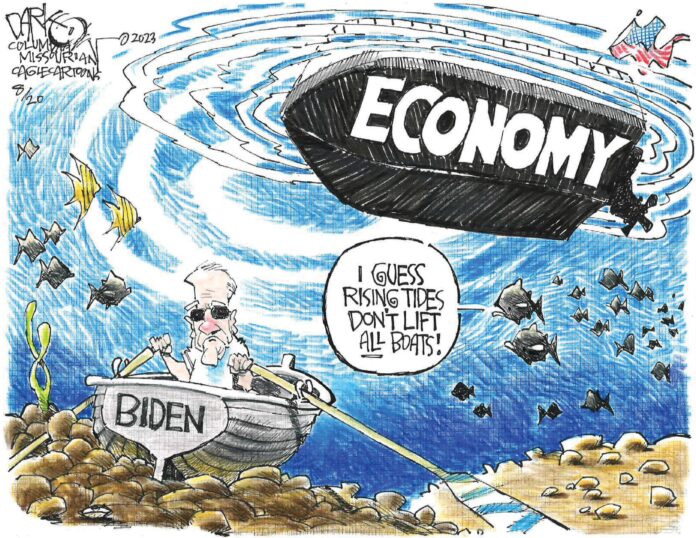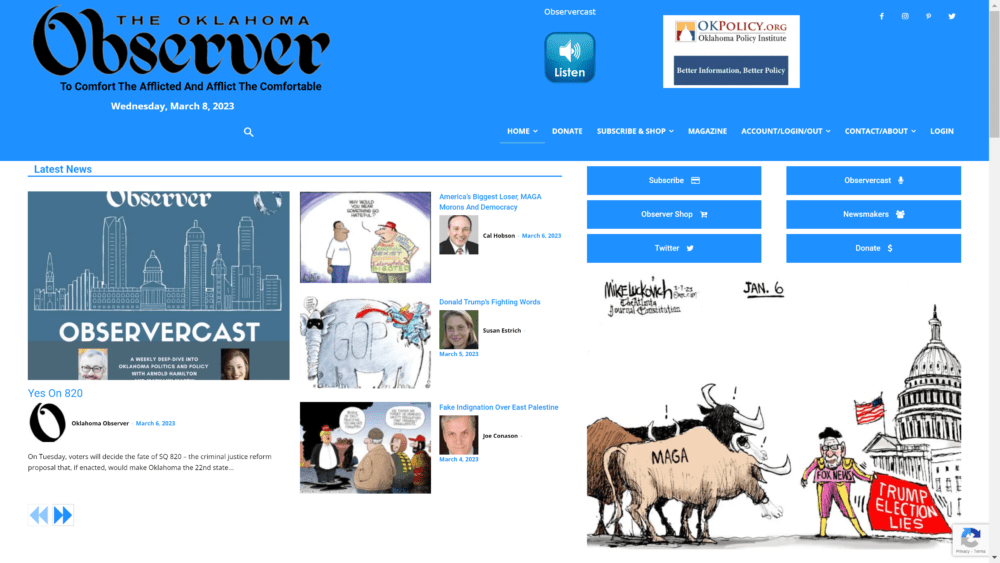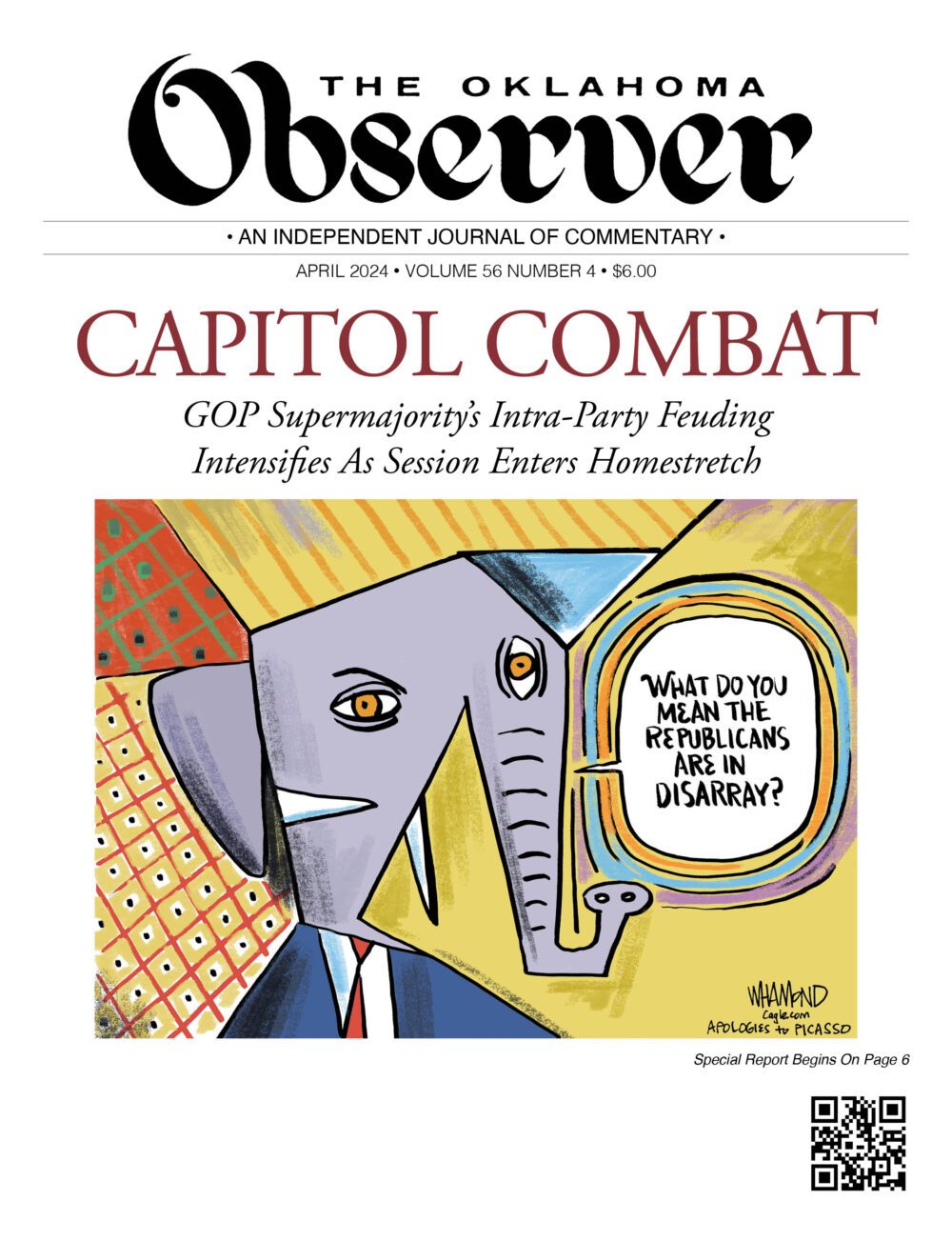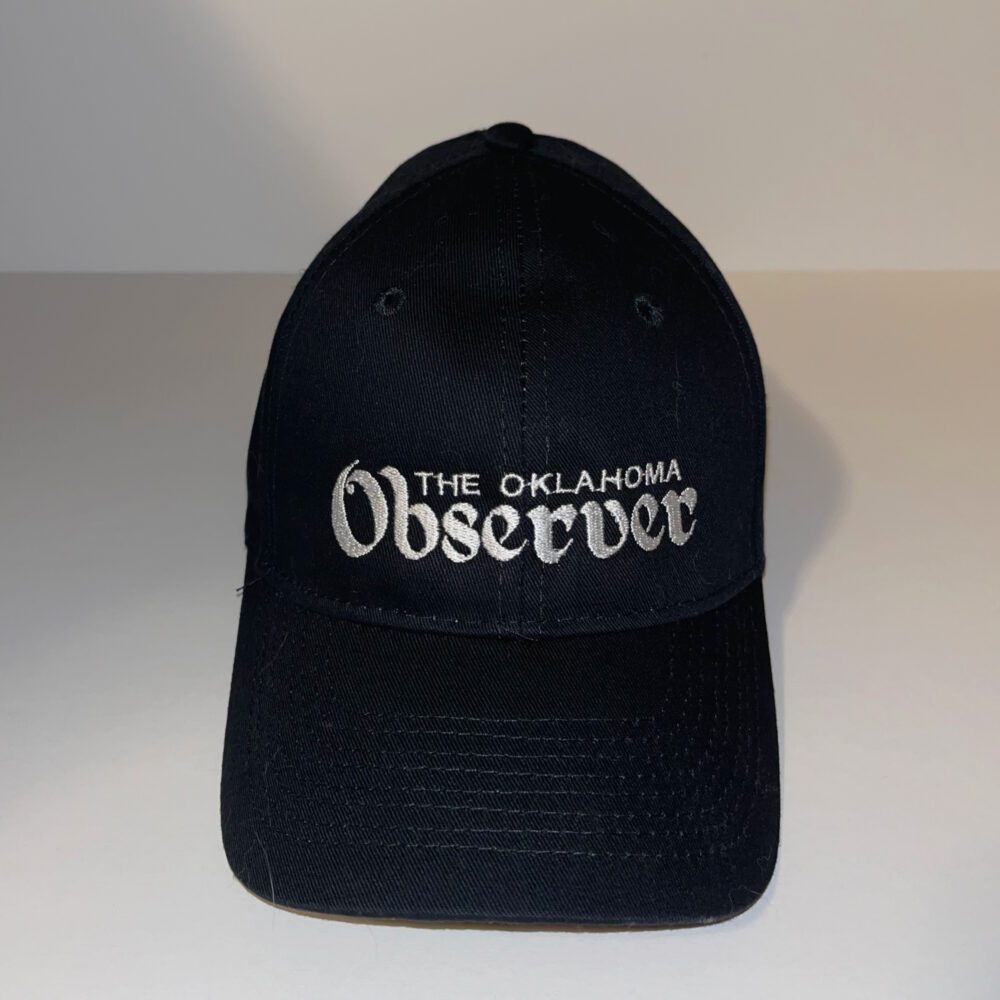During his State of the Union address, President Joe Biden reminded us with a wry smile that ObamaCare “is still a very big deal.” This was a sardonic reference to a more colorful version of that comment Biden made when President Obama signed the Affordable Care Act into law.
As president, Biden has implemented his own historic policies with “big deal” impacts on American lives, including the lives of Oklahomans. Despite their significance, these accomplishments often go unnoticed.
Let’s take a look, then, at some of the positive effects of Biden’s economic policies here in Oklahoma.
BIDENOMICS 101
The simplest way to describe “Bidenomics” is to contrast it to its Republican counterpart: “Reaganomics.”
Starting with Present Ronald Reagan’s administration, the Republican economic agenda has basically remained the same. Since 1980, the GOP has embraced “trickle-down,” supply-side economics, the notion that increasing financial benefits to wealthy corporations and individuals – through tax cuts and deregulation – will stimulate a sharing of the largess with other Americans.
Political historian Heather Cox Richardson describes this as “the idea that consolidating wealth at the top of the economy would enable businessmen to invest far more effectively in new development than they could if the government interfered, and the economy would boom.” Even George H.W. Bush, during his 1980 primary run against Reagan, dismissed this as “voodoo economics.” [He swallowed his skepticism after becoming Reagan’s running mate.]
What history has shown us is that the economic benefits of Reaganomics with few exceptions have failed to trickle down. Those at the top of our economy have instead gorged on an increased accumulation of riches. This perpetuates the ever-widening gap between the wealthiest Americans and the rest of us.
The Biden Administration’s framework is designed to disentangle economic policy from that supply-side model. As he explained in the State of the Union address, Biden’s plan seeks to “grow the economy from the bottom up and the middle out.” Biden added: “I grew up in a home where not a lot trickled down … That’s why I’m determined to turn things around so the middle class does well, the poor have a way up, and the wealthy still [do] well.”
The way to achieve this is through targeted public investments supported by tax reforms in which corporations and the wealthy “pay their fair share.” The federally funded projects create jobs, enhance public and environmental health, and benefit underserved populations. The goal is a more equitable economy for all Americans, not just the top 10%.
This is Bidenomics.
MAKING IT HAPPEN:
BRAGGING RIGHTS WORTH OF AN F-BOMB
To make this vision a reality, the administration has been infusing programs that address local needs with increased federal funding. These programs, in turn, stimulate economic growth. Since Congress controls the purse strings, this can only be done through legislation. Despite the rigidly partisan dynamics in Congress, the Administration has scored several major legislative wins. This in itself is a “big deal” worthy of an f-bomb.
Major economic policies are being implemented, for example, through the Bipartisan Infrastructure Law, the Inflation Reduction Act, the CHIPS and Science Act, and the American Rescue Plan Act.
Positive results are already evident in strong economic data. Among the administration’s bragging rights, nationally, are a record 15 million new jobs created in the past 3 years; 800,000 new manufacturing jobs [including tens of thousands of jobs resulting from $650 billion of private investment in the “green energy” sector]; reduced prescription drug prices for Medicare beneficiaries; creation of 16 million new small businesses; and funding for 46,000 new infrastructure projects. With ongoing implementation of Bidenomics, there should be more good news to come.
A BIG DEAL IN THE SOONER STATE
What about here in Oklahoma? While it may not be widely known except to those administering the funds, we in Oklahoma are rapidly seeing positive results from these investments.
Manufacturing Jobs
According to the White House, since President Biden took office, companies have committed over $3 billion in private sector investments in our state, creating good jobs that pay well.
For example, Canoo, a manufacturer of electric vehicles, is expanding their presence in Oklahoma with an expected 700 additional high-paying jobs ranging from R&D and software development to customer support. USA Rare Earth, meanwhile, will develop a $100 million facility in Stillwater. Their output will reduce reliance on Chinese supply chains for electric vehicle parts, clean energy, electronics, and other manufacturing sectors.
Infrastructure Projects: Roads & Bridges, Internet Access, Water Systems, and More
Almost $3 billion in federal funding has been earmarked for 207 infrastructure projects in our state. The bulk of this will fund road, bridges, and roadway safety projects. It also includes more than $250 million for projects that will improve Oklahomans’ access to clean water. Just a few of the new major, federal investments in Oklahoma infrastructure are described below.
In Tulsa, a Department of Transportation grant has been awarded to study the partial removal of I-244 where it bisects the historical “Black Wall Street” area of Greenwood, which had a devastating effect on the vitality of that once-thriving business community.
Oklahoma has received $1.6 billion for high-speed internet. This includes almost $800 million to provide access to high-speed internet services for all Oklahoma residents. More than $12 million in grants have been awarded to the Eastern Shawnee Tribe of Oklahoma and the Apache Tribe of Oklahoma to improve access to reliable internet services for their members.
Over $68 million is dedicated to replacing lead water pipes and service lines statewide. This does not include another $56 million dollars allocated for safe drinking water investments, which can also support lead pipe replacement.
$28 million is funding accelerated critical maintenance work along the McClellan-Kerr Arkansas River Navigation System’s locks and dams. Like other listed initiatives, this will create jobs.
Statewide, Oklahoma can expect to receive over $350 million over five years under the Bipartisan Infrastructure Law to improve public transportation. More than $125 million of these funds have already been allocated to improve public transit options across the state. In Oklahoma City, $6.7 million has been approved to replace aging EMBARK diesel buses with buses that utilize compressed natural gas.
Oklahoma has already been allocated over $38 million to build a network of electric vehicle charging stations. We can expect to receive about $66 million for this overall in the next five years.
Oklahoma has received about $65 million in federal funding for airports, and another $109 million for ports and waterways. These projects will improve transportation infrastructure while at the same time creating good jobs.
The U.S. Department of Transportation is awarding $85 million to upgrade the I-44/US-75 interchange, improving congestion and travel times as well as safety. Carbon dioxide emissions will decrease. Accidents in the area are expected to go down by 45%.
The Department of Transportation has also awarded $25 million to the Choctaw Nation for the Ilkoli Falummi Project to construct roadways and bicycle paths. In addition to their potential health benefits, the bicycle lanes will increase connections between residential developments and daily destinations in the community.
The U.S. Department of Energy awarded $50 million to make the OG&E power grid more adaptable to the extreme weather unique to its service area. This investment will create a smart grid platform supporting a clean energy economy with more new jobs.
ARPA Grants for Health, Mental Health, Job Training, and Green Energy
The American Rescue Plan Act, or ARPA, supports the Biden Administration’s recovery efforts from the economic crisis the COVID pandemic triggered. ARPA’s grant programs strengthen Oklahoma’s resilience by funding a wide range of initiatives over several years. A sampling from last year includes:
Oklahoma CareerTech received $6.2 million to expand truck driver education as an effort to clear the six-month long student wait list for training enrollment. CareerTech recently received their first shipment of semitrucks purchased for this purpose using ARPA funds. CareerTech is expanding its statewide training program to accelerate the pipeline from training to good-paying truck driving jobs. ARPA money is being used to build new classrooms and training tracks and work four new regional training programs in the state along with acquiring trucks, trailers, and simulators.
Mental health services at the Oklahoma Children’s Hospital Behavioral Health Center and Oklahoma Pediatric Behavioral Health Center have received ARPA funding of $7.5 million and $39.4 million respectively, as has the OSU Medical Authority for a telemedicine pilot program [$10 million].
ARPA funds have also gone to the Oklahoma Military Department for first responder training and other programs benefiting the state’s National Guard.
Over $5 million was allocated to expand mobile dental treatment in the state last year.
$110 million was allocated to the Oklahoma Water Resources Board for water/sewer grants in small and mid-to-large communities, along with rehabilitating high hazard dams in small communities. These projects strengthen our state’s infrastructure and provide good jobs.
The list goes on and on – for fifty-three pages, in fact, that make up Oklahoma’s 2023 ARPA report. The complete report is available online at https://oklahoma.gov/arpa/arpa-reports.html.
OKLAHOMA IS ON THE MONEY TRAIL
Thanks to Bidenomics, the money trail into our state is impressive. It is a complex system of investments benefiting the people living in our towns, rural areas, and cities, and in the infrastructure that connects us all into one entity: the state of Oklahoma.
Like the rest of the country, we in Oklahoma are better off for Bidenomics. Achieving its goals is still a work in progress. The positive impact seen to date is impressive and will become even more impressive as outcomes continue to be measured, funds continue to be allocated, and legislative victories providing additional opportunities for economic growth continue to be won.
Taken all together, this is a big f’in’ deal.







